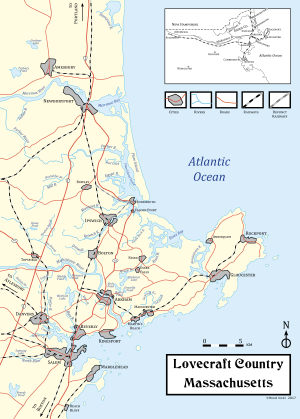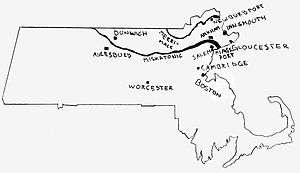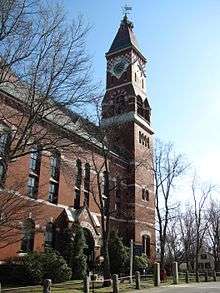Lovecraft Country
Lovecraft Country is the New England setting used by H. P. Lovecraft in many of his weird fiction stories, which combines real and fictitious locations. This setting has since been elaborated on by other writers working in the Cthulhu Mythos. The term was first coined by Keith Herber and then popularized by Chaosium, the producers of the Lovecraftian role-playing game Call of Cthulhu. Lovecraft scholar S. T. Joshi refers to the area as the Miskatonic region, after its fictional river and university.[1] Lovecraft biographer Lin Carter calls it Miskatonic County,[2] and the film Color Out of Space refers to it as Arkham County, although Lovecraft indicates that at least some of his fictional towns were located in the real-life Essex County of Massachusetts.[3]

In its 1998 supplement Dead Reckonings, Chaosium defined Lovecraft Country as "a land located in the northeast of Massachusetts. The most important portion stretches along the Miskatonic River valley, from Dunwich in its far western headwaters to its mouth entering the Atlantic Ocean between Arkham, Kingsport, and Martin's Beach."[4] These locations, along with Innsmouth, are a list of the most significant locations in Lovecraft Country. However, as certain Lovecraft stories take place in other areas of New England, including southern hills of Vermont (the setting of The Whisperer in Darkness) as well as Lovecraft's hometown of Providence, Rhode Island, where he set such works as The Case of Charles Dexter Ward and The Haunter of the Dark, this broader area is sometimes to also be considered part of Lovecraft Country.
Lovecraft's fiction

Lovecraft first used a New England setting in his 1920 short story "The Terrible Old Man", set in Kingsport. "The Picture in the House" (written later in 1920), is the first of his stories to mention both Arkham and the Miskatonic Valley. The story begins with something of a manifesto for why the New England countryside is a fitting backdrop for his horror stories:
"the true epicure of the terrible, to whom a new thrill of unutterable ghastliness is the chief end and justification of existence, esteem most of all the ancient, lonely farmhouses of backwoods New England; for there the dark elements of strength, solitude, grotesqueness, and ignorance combine to form the perfection of the hideous." [5]
In a 1930 letter to Robert E. Howard, Lovecraft attempted to explain his fascination with New England as a setting for weird fiction: "It is the night-black Massachusetts legendary which packs the really macabre 'kick'. Here is material for a really profound study in group neuroticism; for certainly, none can deny the existence of a profoundly morbid streak in the Puritan imagination."[6]
Lovecraft first mentioned Arkham's Miskatonic University in "Herbert West–Reanimator", written in 1921–22. He added Dunwich to his imaginary landscape in 1928's "The Dunwich Horror",[7] and expanded it to include Innsmouth in 1931's The Shadow over Innsmouth.[8]
Other Lovecraft stories that make use of Lovecraft Country settings include "The Festival", "The Colour out of Space", "The Strange High House in the Mist", "The Dreams in the Witch House", and "The Thing on the Doorstep".
Derleth's additions
August Derleth, Lovecraft's friend and literary executor, discouraged other Cthulhu Mythos writers from setting their stories in Lovecraft's New England. But he himself attempted to fill in the blanks of the setting, particularly in his posthumous "collaborations" with Lovecraft—actually Derleth's stories based on fragments, notes or ideas that Lovecraft left behind after his death.
The Lurker at the Threshold is set in Billington's Wood, a fictional forest north of Arkham, while "Witches' Hollow" takes place in the titular valley in the hills to the west of the town. The title of "The Fisherman of Falcon Point" refers to a promontory on the Atlantic coast south of Innsmouth. "Wentworth's Day" and "The Horror from the Middle Span" take place in the area north of Dunwich, while "The Gable Window" concerns a house on the Aylesbury Pike.
Roleplaying games
Between 1990 and 1998, Chaosium released a number of Lovecraft Country gamebooks for the Call of Cthulhu roleplaying game, series created by author/editor Keith Herber. Most were background supplements which codified descriptions of Lovecraft's named cities, but there were also a number of adventure books. These included:
- Arkham Unveiled (1990)
- Return to Dunwich (1991)
- Kingsport: The City in the Mist (1991)
- Escape from Innsmouth (1992)
- Adventures in Arkham Country (1993)
- Miskatonic University (1994)
- Tales of the Miskatonic Valley
- Dead Reckonings (1998)
- Before the Fall (1998)
- Children of the Deep (unreleased sequel that explored Innsmouth after its fall described in Escape from Innsmouth)
Some of the books have been rereleased in the 2000s (H.P. Lovecraft's Dunwich, H.P. Lovecraft's Arkham, and H.P. Lovecraft's Kingsport).
Skotos, an online game company, has licensed Chaosium's Lovecraft Country material. They have produced two games, Lovecraft Country: The Tomb of the Desert God and Lovecraft Country: Arkham by Night, as well as a comic, Lovecraft Country: Return to Arkham, written by Shannon Appelcline.[9]
In 2008, following Chaosium's expanded licensing program for Call of Cthulhu, Keith Herber and Tom Lynch established Miskatonic River Press. The publisher's first release, New Tales of the Miskatonic Valley, which marked both Herber's return to Call of Cthulhu and Lovecraft Country was announced published in 2009.
Other uses
The phrase Lovecraft Country is now used outside of the Cthulhu gaming community. Return to Lovecraft Country was a collection of short stories set in "the New England of H.P. Lovecraft", published by Triad Entertainments in 1996. The editor, Scott David Aniolowski, has also done editorial work for Chaosium. Eternal Lovecraft, a short-story collection published by Golden Gryphon Press in 1998, has a section called "Lovecraft Country". Lovecraft Country was the title of a 2016 novel by Matt Ruff.
The phrase occurs in popular discussions of Lovecraft's connection to the region. The Harvard Law Record used the phrase in an October 20, 2005 article:
Many Lovecraft stories take place in "Lovecraft Country"—the fictional North Shore towns of Arkham, Innsmouth, Kingsport, and Dunwich (perhaps fictional equivalents of Ipswich, Salem/Danvers, Marblehead, or Newburyport).[10]
Locations
Kingsport
Kingsport is a fictional town in the writings of H. P. Lovecraft and used by subsequent writers in his tradition. The town first appeared in Lovecraft's short story "The Terrible Old Man" (1921).
- Inspiration

in Marblehead, Massachusetts
Kingsport is based on Marblehead, Massachusetts, a town bordering Salem. Lovecraft created Kingsport before he saw its real-life model. When Lovecraft visited Marblehead in 1922, he became enamored of the town and wrote with much feeling in 1929 concerning his experiences there. Lovecraft wrote of seeing the snow-covered town at sunset and of experiencing his "first stupid glance of [Marblehead's] huddled and [archaic] roofs". He also remarked that "that instant — about 4:05 to 4:10 pm., Dec. 17, 1922 — [was] the most powerful single emotional climax during my nearly forty years of existence." [11]
- Fictional characteristics
In Lovecraft's fiction, Kingsport is located in the United States to the southeast of (the fictitious) Arkham and corresponds geographically with the town of Marblehead, MA. Lovecraft's alter ego Randolph Carter grew up and lived here.
According to later writers, the town was founded in 1639 by colonists from southern England and the Channel Islands. It soon became a seaport and center for shipbuilding. Influenced by the Salem witch trials, the town hanged four alleged witches in 1692. During the American Revolutionary War, the port was briefly blockaded by the British when the town's merchants turned to privateering against the British fleet. In the 19th century, sea trade dwindled and the town turned to fishing as the main industry. Kingsport's economy continued to dwindle into the 20th century and today relies primarily on tourism for income.[12]
- Appearances in Lovecraft
- "The Terrible Old Man" (1921): The eponymous resident of Kingsport lives on Water Street near the sea.
- "The Festival" (1923): The unnamed narrator is summoned to Kingsport to participate in a strange ceremony held by his distant relatives.
- The Dream-Quest of Unknown Kadath (1926): Nyarlathotep expresses admiration for Kingsport's "antediluvian" architecture and marvelous seacoast. A moving conclusion to the novella takes place here.
- "The Silver Key" (1926): Randolph Carter has traveled back in time to the 1880s when he glimpses Kingsport's "old Congregational steeple on Central Hill" and realizes that the old church had been torn down to build Congregational Hospital.
- "The Strange High House in the Mist" (1926): College teacher Thomas Olney meets the lone occupant of the eponymous dwelling, which lies atop a high cliff on Kingsport's coast.
- The Case of Charles Dexter Ward (1927): John Merritt mentions Kingsport and the strange rites he had heard were performed there.
- "The Thing on the Doorstep" (1933): A teenaged Asenath Waite attended an all-girls school, the Hall School, in Kingsport.
- In works by other writers
The town was mentioned in Robert Bloch's short story "Notebook Found in a Deserted House" and The Illuminatus! Trilogy by Robert Shea and Robert Anton Wilson, and appeared in An Evil Guest by Gene Wolfe. The original draft of Ramsey Campbell's "The Church in High Street" was set in Kingsport, before August Derleth persuaded Campbell to rewrite the story in a British setting; the town Temphill.
- In games
- Kingsport appears in the tabletop games Call of Cthulhu, Kingsport Festival, and in an expansion to Arkham Horror. The Call of Cthulhu sourcebook Kingsport: The City in the Mists provides maps, history and other information for roleplayers and game masters.
- Kingsport is one of four towns on the board in the tabletop game Pandemic: Reign of Cthulhu (2016), a variant of Pandemic (2008).
- The Kingsport Lighthouse is a location and possible settlement in the video game Fallout 4.
- In other media
- Kingsport is mentioned as the home of an American couple visiting Oxford in the British police procedural TV program "Endeavour."
- The episode name is "Nocturne." Broadcast on 6 July 2014.
Notes
- More Annotated H. P. Lovecraft, S.T. Joshi and Peter Cannon
- Lovecraft: A Look Behind the Cthulhu Mythos, Lin Carter
- See "Shadow Over Innsmouth", "Dreams in the Witch House".
- Dead Reckonings, Kevin Ross & Shannon Appel eds.
- "H. P. Lovecraft's 'The Picture in the House'", The H. P. Lovecraft Archive.
- The Annotated Lovecraft, Joshi and Cannon, p. 2
- The Dunwich Horror, by H. P. Lovecraft. Lovecraft's original story featuring Dunwich.
- The Shadow over Innsmouth, by H. P. Lovecraft. Lovecraft's original story featuring Innsmouth.
- Skotos: Lovecraft Country
- "Spirit of Lovecraft Haunts Cambridge, New England", Dan Alban, The Record, October 20, 2005
- Pearsall, Anthony B. (2005). "Kingsport". The Lovecraft Lexicon (1st ed.). Tempe, AZ: New Falcon Pub. p. 247. ISBN 1-56184-129-3.
- Harms, Daniel (1998). "Kingsport". The Encyclopedia Cthulhiana (2nd ed.). Oakland, CA: Chaosium. pp. 166–167. ISBN 1-56882-119-0.
External links
- "A Short Tour of Lovecraftian New England", from The Cthulhu Mythos: A Guide
- Chaosium's (empty) Lovecraft Country Page
- Skotos' Lovecraft Country Game Pages
- Return to Lovecraft Country Book (ISBN 1-57502-535-3)
- Eternal Lovecraft Book (ISBN 0-9655901-7-8)
- Lovecraftian Sites in New England
- The Virtual World of H.P. Lovecraft, an ongoing mapping of Lovecraft's imaginary New England